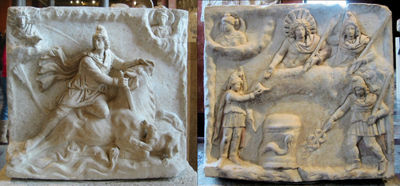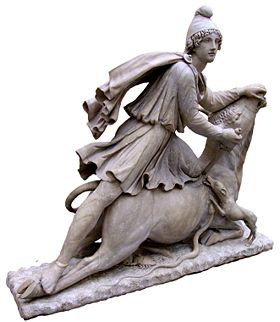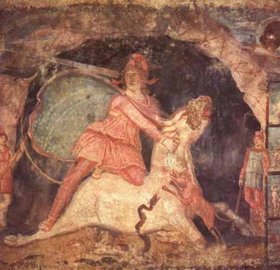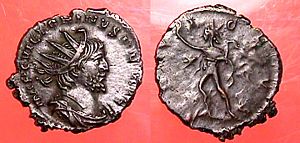Mithraic Mysteries
2008/9 Schools Wikipedia Selection. Related subjects: Divinities

Front:Mithras killing the bull, being looked over by the Sun god and the Moon god.
Back: Mithras banquetting with the Sun god.
The Mithraic Mysteries or Mysteries of Mithras (also Mithraism) was a mystery religion practised in the Roman Empire (1st to 4th centuries CE), best attested in Rome and Ostia, Mauretania, Britain and in the provinces along the Rhine and Danube frontier.
Rituals and worship
Mithraism was an initiatory order, passed from initiate to initiate, like the Eleusinian Mysteries. It was not based on a body of scripture, and hence very little written documentary evidence survives. Soldiers and the lower nobility appeared to be the most plentiful followers of Mithraism. Until recently, women were generally thought to not have been allowed to join, but it has now been suggested that "women were involved with Mithraic groups in at least some locations of the empire." Recently revealed discrepancies such as these suggest that Mithraic beliefs were (contra the older supposition) not internally consistent and monolithic,cf. but rather, varied from location to location.
No Mithraic scripture or first-hand account of its highly secret rituals survives, with the possible exception of a liturgy recorded in a 4th century papyrus, thought to be an atypical representation of the cult at best. Current knowledge of the mysteries is almost entirely limited to what can be deduced from the iconography in the mithraea that have survived.
The mithraeum
Religious practice was centered around the mithraeum (Latin, from Greek mithraion), either an adapted natural cave or cavern or an artificial building imitating a cavern. Mithraea were dark and windowless, even if they were not actually in a subterranean space or in a natural cave. When possible, the mithraeum was constructed within or below an existing building. The site of a mithraeum may also be identified by its separate entrance or vestibule, its "cave", called the spelaeum or spelunca, with raised benches along the side walls for the ritual meal, and its sanctuary at the far end, often in a recess, before which the pedestal-like altar stood. Many mithraea that follow this basic plan are scattered over much of the Empire's former area, particularly where the legions were stationed along the frontiers (such as Britain). Others may be recognized by their characteristic layout, even though converted as crypts beneath Christian churches.
From the structure of the mithraea it is possible to surmise that worshippers would have gathered for a common meal along the reclining couches lining the walls. Most temples could hold only thirty or forty individuals.
The mithraeum itself was arranged as an "image of the universe". It is noticed by some researchers that this movement, especially in the context of mithraic iconography (see below), seems to stem from the neoplatonic concept that the "running" of the sun from solstice to solstice is a parallel for the movement of the soul through the universe, from pre-existence, into the body, and then beyond the physical body into an afterlife.
Mithraic ranks
The members of a mithraeum were divided into seven ranks. All members were expected to progress through the first four ranks, while only a few would go on to the three higher ranks. The first four ranks represent spiritual progress—the new initiate became a Corax, while the Leo was an adept—the other three have been specialized offices. The seven ranks were:
- Corax (raven)
- Nymphus (bridegroom)
- Miles (soldier)
- Leo (lion)
- Perses (Persian)
- Heliodromus (sun-courier)
- Pater (father)
The titles of the first four ranks suggest the possibility that advancement through the ranks was based on introspection and spiritual growth.
The tauroctony
In every Mithraic temple, the place of honour was occupied by a tauroctony, a representation of Mithras killing a sacred bull which was associated with spring. Mithras is depicted as an energetic young man, wearing a Phrygian cap, a short tunic that flares at the hem, pants and a cloak which furls out behind him. Mithras grasps the bull so as to force it into submission, with his knee on its back and one hand forcing back its head while he stabs it in the neck with a short sword. The figure of Mithras is usually shown at a diagonal angle and with the face turned forward. The representations occur as both reliefs, and as three-dimensional sculpture; however the three dimensional images have a strongly frontal aspect.
A serpent and a dog seem to drink from the bull's open wound which is sometimes depicted as spilling grain rather than blood, and a scorpion (usually interpreted as a sign for autumn) attacks the bull's testicles sapping the bull for strength. Sometimes, a raven or crow is also present, and sometimes also a goblet and small lion. Cautes and Cautopates, the celestial twins of light and darkness, are torch-bearers, standing on either side with their legs crossed, Cautes with his brand pointing up and Cautopates with his turned down. Above Mithras, the symbols for Sol and Luna are present in the starry night sky.
The Platonic writer Porphyry, recorded, in the 3rd century CE that the cave-like temple Mithraims depicted "an image of the cosmos" or "great cave" of the sky. This interpretation was supported by research by K. B. Stark in 1869, with astronomical support by Roger Beck (1984 and 1988), David Ulansey (1989) and Noel Swerdlow (1991).
It has been proposed by David Ulansey that, rather than being derived from Iranian animal sacrifice scene with Iranian precedents, the tauroctony is a symbolic representation of the constellations. The bull is thus interpreted as representing the constellation Taurus, the snake the constellation Hydra, the dog Canis Major or Minor, the crow or raven Corvus, the goblet Crater, the lion Leo, and the wheat-blood for the star Spica, the name of which means "spike of wheat". The torch-bearers may represent the constellation of Gemini which seasonally follows that of Taurus, or possibly the two equinoxes. Mithras is associated by many writers with the constellation of Orion because of the proximity to Taurus, and the consistent nature of the depiction of the figure as having wide shoulders, a garment flared at the hem, and narrowed at the waist with a belt, thus taking on the form of the constellation. It is also possible that could also be associated with Perseus, whose constellation is above that of the Taurus in the sky.
Cumont hypothesized (since then discredited) that this imagery was a Greco-Roman representation of an event in Zoroastrian cosmogony, in which Angra Mainyu (not Mithra) slays the primordial creature Gayomaretan (which in Zoroastrian tradition is represented as a bull).
Other iconography
Depictions show Mithras (or who is thought to represent Mithras) wearing a cape, that in some examples, has the starry sky as its inside lining. (See image below)
A bronze image of Mithras emerging from an egg-shaped zodiac ring was found associated with a mithraeum along Hadrian's Wall (now at the University of Newcastle). An inscription from the city of Rome suggests that Mithras may have been seen as the Orphic creator-god Phanes who emerged from the world egg at the beginning of time, bringing the universe into existence. This view is reinforced by a bas-relief at the Estense Museum in Modena, Italy, which shows Phanes coming from an egg, surrounded by the twelve signs of the zodiac, in an image very similar to that at Newcastle.
Reliefs on a cup found in Mainz, appear to depict a Mithraic initiation. On the cup, the initiate is depicted as led into a location where a Pater (see Mithraic ranks) would be seated in the guise of Mithras with a drawn bow. Accompanying the initiate is a mystagogue, who explains the symbolism and theology to the initiate. The Rite is thought to re-enact what has come to be called the 'Water Miracle', in which Mithras fires a bolt into a rock, and from the rock now spouts water.
History and development
In antiquity, texts refer to "the mysteries of Mithras", and to its adherents, as "the mysteries of the Persians." This latter epithet is significant, not only for whether the Mithraists considered the object of their devotion a Persian divinity (i.e. Mithra), but for whether the devotees considered their religion to have been founded by Zoroaster.
It is not possible to state with certainty when "the mysteries of Mithras" developed. Clauss asserts "the mysteries" were not practiced until the 1st century CE. Mithraism reached the apogee of its popularity around the 3rd through 4th centuries, when it was particularly popular among the soldiers of the Roman Empire. Mithraism disappeared from overt practice after the Theodosian decree of 391 banned all pagan rites, and it apparently became extinct thereafter.
Although scholars are in agreement with the classical sources that state that the Romans borrowed the name of Mithras from Avestan Mithra, the origins of the Roman religion itself remain unclear and there is yet no scholarly consensus concerning this issue (for a summary of the various theories, see history, below). Further compounding the problem is the non-academic understanding of what "Persian" means, which, in a classical context is not a specific reference to the Iranian province Pars, but to the Persian (i.e. Achaemenid) Empire and speakers of Iranian languages in general.
Origin theories
Cumont's hypothesis
'Mithras' was little more than a name until the massive documentation of Franz Cumont's Texts and Illustrated Monuments Relating to the Mysteries of Mithra was published in 1894-1900, with the first English translation in 1903. Cumont's hypothesis, as the author summarizes it in the first 32 pages of his book, was that the Roman religion was a development of a Zoroastrian cult of Mithra (which Cumont supposes is a development from an Indo-Iranian one of *mitra), that through state sponsorship and syncretic influences was disseminated throughout the Near- and Middle East, ultimately being absorbed by the Greeks, and through them eventually by the Romans.
Cumont's theory was a hit in its day, particularly since it was addressed to a general, non-academic readership that was at the time fascinated by the orient and its hitherto (relatively) uncharted culture. This was the age when great steps were being taken in Egyptology and Indology, preceded as it was by Max Müller's "Sacred Books of the East" series that for the first time demonstrated that civilization did not begin and end with Rome and Greece, or even with Assyria and Babylon, which until then were widely considered to be the cradle of humanity. Cumont's book was a product of its time, and influenced generations of academics such that the effect of Cumont's syncretism theories are felt even a century later.
Cumont's ideas, though in many respects valid, had however one serious problem with respect to the author's theory on the origins of Mithraism: If the Roman religion was an outgrowth of an Iranian one, there would have to be evidence of Mithraic-like practices attested in Greater Iran. However, that is not the case: No mithraea have been found there, and the Mithraic myth of the tauroctony does not conclusively match the Zoroastrian legend of the slaying of Gayomart, in which Mithra does not play any role at all. The historians of antiquity, otherwise expansive in their descriptions of Iranian religious practices, hardly mention Mithra at all (one notable exception is Herodotus i.131, which associates Mithra with other divinities of the morning star).
Further, no distinct religion of Mithra or *mitra had ever (and has not since) been established. As Boyce put it, "no satisfactory evidence has yet been adduced to show that, before Zoroaster, the concept of a supreme god existed among the Iranians, or that among them Mithra - or any other divinity - ever enjoyed a separate cult of his or her own outside either their ancient or their Zoroastrian pantheons."
It should however be noted that while it is "generally agreed that Cumont's master narrative of east-west transfer is unsustainable," a syncretic Zoroastrian (whatever that might have entailed at the time) influence is a viable supposition. This does not however imply that the religion practiced by the Romans was the same as that practiced elsewhere; syncretism was a feature of Roman religion, and the syncretic religion known as the Mysteries of Mithras is a product of Roman culture itself. "Apart from the name of the god himself, in other words, Mithraism seems to have developed largely in and is, therefore, best understood from the context of Roman culture."
Other theories
Other theories propose that Mithraism originated in Asia Minor, which though once within the sphere of Zoroastrian influence, by the second century BCE were more influenced by Hellenism than by Zoroastrianism. It was there, at Pergamum on the Aegean Sea, in the second century BCE, that Greek sculptors started to produce the highly standardized bas-relief imagery of Mithra Tauroctonos "Mithra the bull-slayer."
The Greek historiographer Plutarch (46 - 127) was convinced that the pirates of Cilicia, the coastal province in the southeast of Anatolia, were the origin of the Mithraic rituals that were being practiced in the Rome of his day: "They likewise offered strange sacrifices; those of Olympus I mean; and they celebrated certain secret mysteries, among which those of Mithras continue to this day, being originally instituted by them." (Life of Pompey 24)
Beck suggests a connection through the Hellenistic kingdoms (as Cumont had already intimated) was quite possible: "Mithras — moreover, a Mithras who was identified with the Greek Sun god, Helios, which was one of the deities of the syncretic Graeco-Iranian royal cult founded by Antiochus I, king of the small, but prosperous "buffer" state of Commagene, in the mid first century BCE."
Another possible connection between a Mithra and Mithras, though one not proposed by Cumont, is from a Manichean context. According to Sundermann, the Manicheans adopted the name Mithra to designate one of their own deities. Sundermann determined that the Zoroastrian Mithra, which in Middle Persian is Mihr, is not a variant of the Parthian and Sogdian Mytr or Mytrg; though a homonym of Mithra, those names denote Maitreya. In Parthian and Sogdian however Mihr was taken as the sun and consequently identified as the Third Messenger. This Third Messenger was the helper and redeemer of mankind, and identified with another Zoroastrian divinity Narisaf. Citing Boyce, Sundermann remarks, "It was among the Parthian Manicheans that Mithra as a sun god surpassed the importance of Narisaf as the common Iranian image of the Third Messenger; among the Parthians the dominance of Mithra was such that his identification with the Third Messenger led to cultic emphasis on the Mithraic traits in the Manichaean god."
Some commentators surmise that the Mithraists worshipped Mithras as the mediator between Man and the supreme God of the upper and nether world. Other commentators, inspired by James Frazer's theories, have additionally labeled Mithraism as a mystery religion with a life-death-rebirth deity, comparable to Isis, or Persephone/ Demeter, the cult of the Eleusinian Mysteries.
The early period
Mithraism began to attract attention in Rome around the end of the first century. Statius mentions the typical Mithraic relief in his Thebaid (Book i. 719,720), around 80 CE. The earliest material evidence for the Roman worship of Mithras dates from that period, in a record of Roman soldiers who came from the military garrison at Carnuntum in the Roman province of Upper Pannonia (near the Danube River in modern Austria, near the Hungarian border). Other legionaries fought the Parthians and were involved in the suppression of the revolts in Jerusalem from 60 CE to about 70 CE When they returned home, they made Mithraic dedications, probably in the year 71 or 72.
By the year 200, Mithraism had spread widely through the army, and also among traders and slaves. During festivals all initiates were equals including slaves. The German frontiers have yielded most of the archaeological evidence of its prosperity: small cult objects connected with Mithras turn up in archaeological digs from Romania to Hadrian's Wall.
Expansion throughout the empire
By the third century, Mithraism was officially sanctioned by the Roman emperors. According to the fourth century Historia Augusta, Commodus participated in its mysteries: Sacra Mithriaca homicidio vero polluit, cum illic aliquid ad speciem timoris vel dici vel fingi soleat "He desecrated the rites of Mithras with actual murder, although it was customary in them merely to say or pretend something that would produce an impression of terror".
Concentrations of Mithraic temples are found on the outskirts of the Roman empire: along Hadrian's wall in northern England three mithraea have been identified, at Housesteads, Carrawburgh and Rudchester. The discoveries are in the University of Newcastle's Museum of Antiquities, where a mithraeum has been recreated. Recent excavations in London have uncovered the remains of a Mithraic temple near to the centre of the once walled Roman settlement, on the bank of the Walbrook stream. Mithraea have also been found along the Danube and Rhine river frontier, in the province of Dacia (where in 2003 a temple was found in Alba-Iulia) and as far afield as Numidia in North Africa.
As would be expected, Mithraic ruins are also found in the port city of Ostia, and in Rome the capital, where as many as seven hundred mithraea may have existed (a dozen have been identified). Its importance at Rome may be judged from the abundance of monumental remains: more than 75 pieces of sculpture, 100 Mithraic inscriptions, and ruins of temples and shrines in all parts of the city and its suburbs. A well-preserved late second-century mithraeum, with its altar and built-in stone benches, originally built beneath a Roman house (as was a common practice), survives in the crypt over which has been built the Basilica of San Clemente, Rome.
Decline and demise
There is very little information about the decline of the religion. The edict of Theodosius I in 394 made paganism illegal. Official recognition of Mithras in the army stopped at this time, but we have no information on what other effect the edict had. Mithraism may have survived in certain remote cantons of the Alps and Vosges into the fifth century.
Legacy
Sites of interest relating to the Mystery of Mithras include:
- Italy: The Basilica of San Clemente in Rome has a preserved mithraeum with the altarpiece still intact in the excavations under the modern church.
- Italy: The Castra Peregrinorum mithraeum in Rome, under the basilica of Santo Stefano Rotondo was excavated in the 20th century.
- Italy: Ostia Antica, the port of Rome, where the remains of 17 mithraea have been found so far; one of them is substantial.
- Germany: The museum of Dieburg displays finds from a mithraeum, including ceramics used in the service.
- Germany: The museum of Hanau displays a reconstruction of a mithraeum.
- England: The museum at the University of Newcastle displays findings from the three sites along Hadrian's Wall and recreates a mithraeum.
- Switzerland: The city of Martigny (ancient Octodurus), in the Alps, displays a reconstructed Mithraeum
- Slovenia: The museum of Ptuj and town Hajdina near Ptuj.
- United States: The Cincinnati Art Museum displays a relief from a mithraeum in Rome itself depicting Mithras slaying a bull.
Mithraism and Christianity
Evaluation of the relationship of early Christianity with Mithraism has traditionally been based on the polemical testimonies of the 2nd century Church fathers, such as Justin's accusations that the Mithraists were diabolically imitating the Christians. This led to a picture of rivalry between the two religions, which Ernest Renan summarized in his 1882 The Origins of Christianity by saying "if the growth of Christianity had been arrested by some mortal malady, the world would have been Mithraic." This characterization of Mithraism and Christianity as "deadly rivals" became mainstream in the early 20th century with Cumont's endorsement, but was later criticized as too sweeping. Martin (1989) characterizes the rivalry between 3rd century Mithraism and Christianity in Rome as primarily one for real estate in the public areas of urban Rome.
Iconographical similarities with Early Christian art
Franz Cumont was the first scholar to suggest that Early Christian art had borrowed iconographic themes from Mithraism, pointing out that Mithraic images of the Heavens, the Earth, the Ocean, the Sun, the Moon, the Planets, signs of the Zodiac, the Winds, the Seasons, and the Elements are found on Christian sarcophagi, mosaics, and miniatures from the third to the fifth centuries. According to Cumont the Church was opposed to the pagan practice of worshipping the cosmic cycle, but these images were nevertheless incorporated into Christian artworks, in which "a few alterations in costume and attitude transformed a pagan scene into a Christian picture".
The Jewish faith provided no precendent of pictorial representation on which the Early Christians could base their imagery. According to Cumont, Early Christian imagery drew upon Mithraic traditions. Depictions of the biblical story of Moses striking Mount Horeb with his staff to release drinking water were, according to Cumont, inspired by Mithraic representation of Mithras shooting arrows at rocks causing fountains to spring up.
M. J. Vermaseren claimed that the scene of Mithras ascending into the heavens was similarly incorporated into Christian art: after Mithras had accomplished a series of miraculous deeds, he ascended into the heavens in a chariot, which in various depictions is drawn by horses being controlled by by Helios-Sol, the pagan sun god. In other depictions a chariot of fire belonging to Helios is led into the water, surrounded by the god Oceanus and sea nymphs. Vermaseren argues that Christian portrayals on sarcophagi of the soul’s ascension into heaven, though ostensibly referencing the biblical scene of Elijah being led into heaven by fiery chariots and horses, were in fact inspired by representations of Mithras' ascent into the heavens in Helios’ chariot. The sun god, Vermaseren claims, provided inspiration for the flames on Elijah’s chariot and the Jordan River is personified by a figure resembling the god Oceanus. Some scholars have also used similar language to describe the circumstances of Mithras' and Jesus' birth: Joseph Campbell described it as a virgin birth, and Martin A. Larson noted that Mithras was said to have been born on December 25th, or winter solstice.
A. Deman suggests that rather than attempting to find individual references from Mithraic art in Christian iconography, as Cumont does with the sun and moon, for instance, it is better to look for larger patterns of comparison: "with this method, pure coincidences can no longer be used and so the recognition of Mithras as the privileged pagan inspirer of medieval Christian iconography is forced upon us." For example Deman compares what he calls the "creative sacrifice" of Mithras with the creative sacrifice of Christ. In representations of both iconographic scenes the vernal sacrifice is central to the image, with sun and the moon symmetrically arranged above. Beneath the sacrifice two other figures are symmetrically arranged. In mithraic scenes these are Cautes and Cautopates, and in the Christian scenes, which date from the 4th century onwards, the figures are typically Mary and John. In other Christian instances however, these two attendants are other figures, and carry a raised and lowered object reminiscent of the raised and lowered torches of Cautes and Cautopates. Such figures may be two Roman soldiers armed with lances, or Longinus holding a spear and Stephaton offering Jesus vinegar from a sponge. In some instances the clothes of these figures resemble those of Cautes and Cautopates in the earlier Mithraic depictions. Derman also compares the twelve apostles shown in Christian crucifixion scenes with the twelve signs of the zodiac common in Mithraic scenes, as well as identifying a cross-legged posture commonly found in figures in both sets of iconography.



